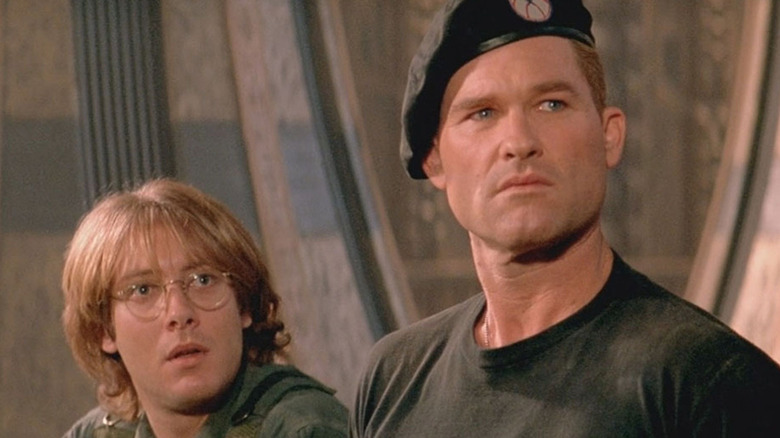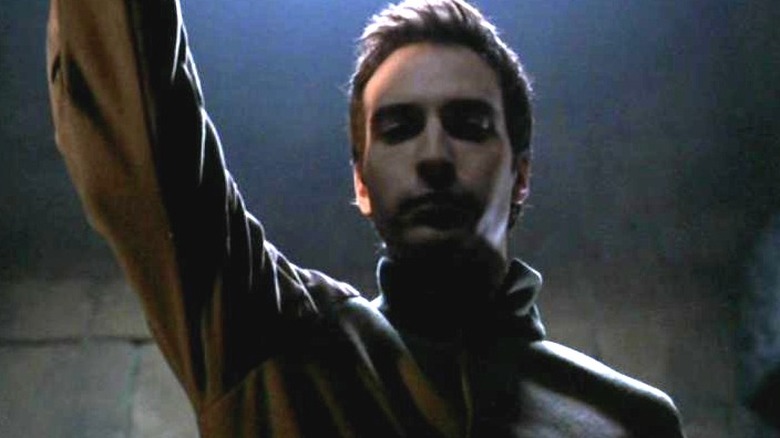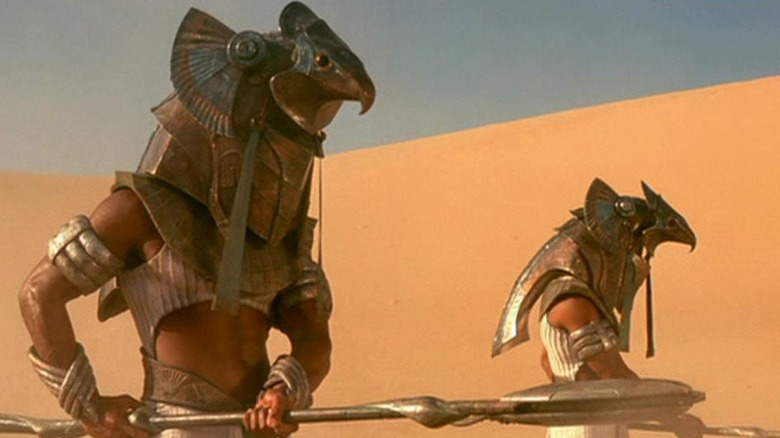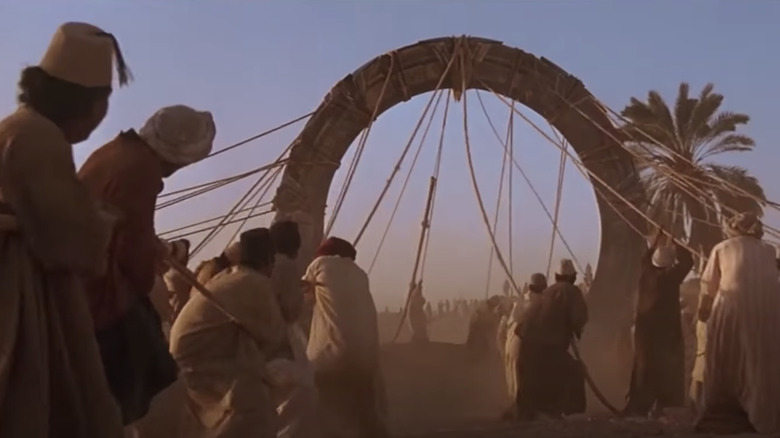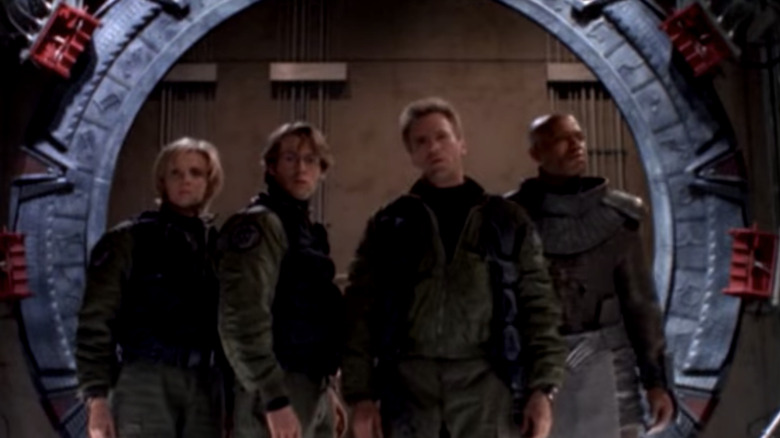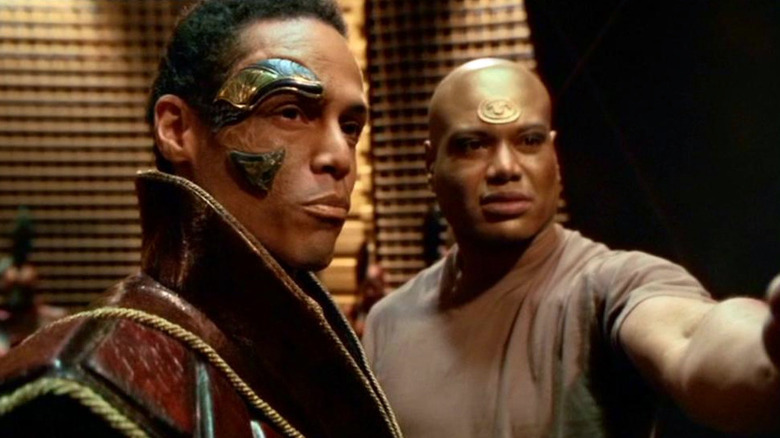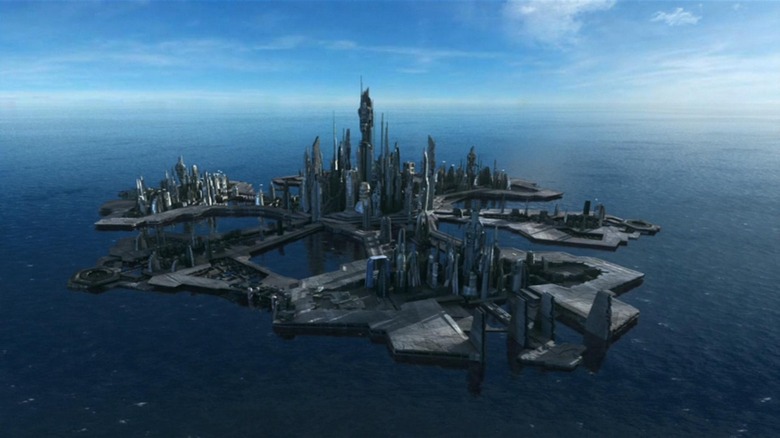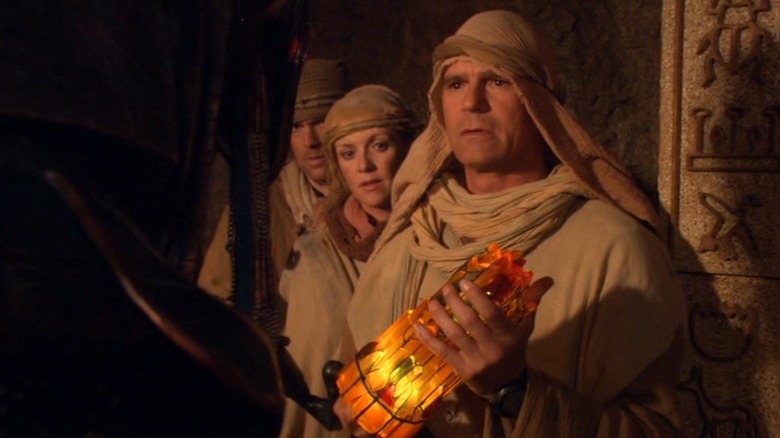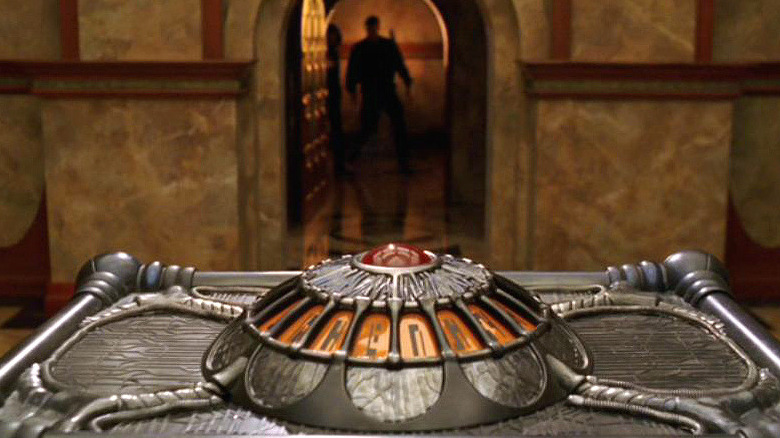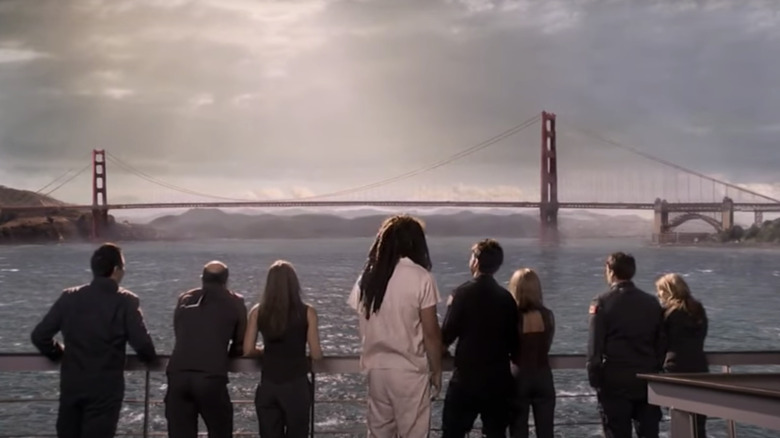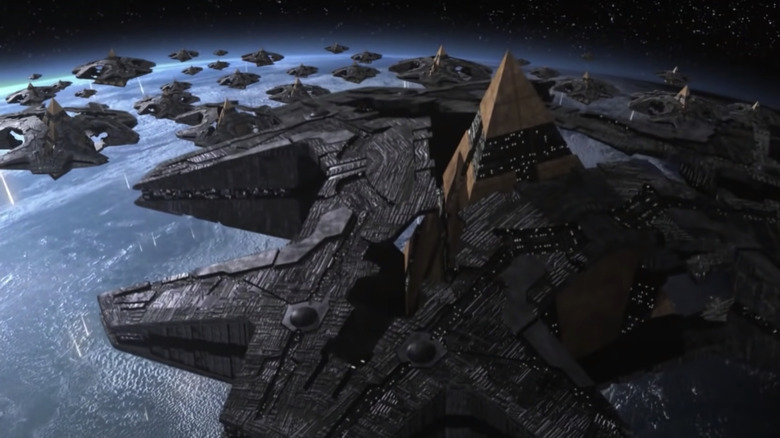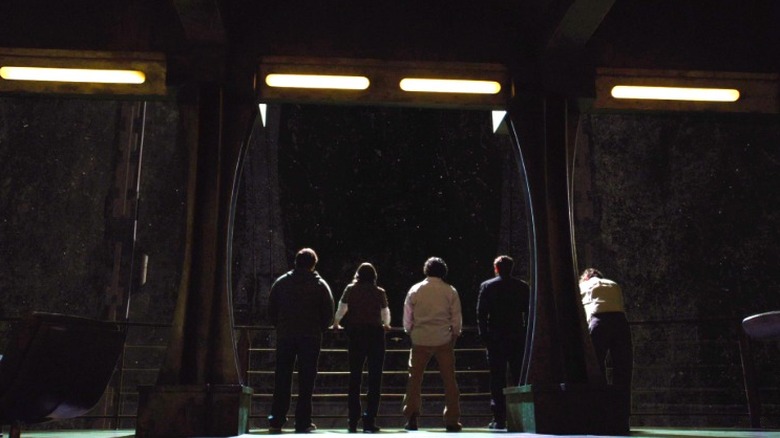The Entire Stargate Timeline Explained
There are so many great modern science-fiction epics to choose from. "Dune" has wowed new and old audiences with its 2021 film adaptation, "Star Wars" fans have been blessed with "The Mandalorian" and "The Book of Boba Fett" these past few years (with more Disney+ shows on the way), and "Star Trek" has found its way back to television. All these genre giants aside, there's no science-fiction franchise quite like "Stargate." What sets "Stargate" apart is its unique blend of military science-fiction tropes with a larger-than-life mythology that combines ancient human history with religion, technology, and interstellar travel. From the moment Roland Emmerich's incredible 1994 motion picture premiered, it was clear that "Stargate" was something more.
With "Stargate SG-1," "Stargate Atlantis," and "Stargate Universe" to cover, as well as a handful of movies and a recent miniseries, it's no wonder that the "Stargate" timeline can be a bit confusing and intimidating. With that in mind, we've decided to string out the series chronology right here, making the "Stargate" timeline from the original film through 2018's "Stargate Origins" a bit easier to sort out. (We won't be talking about "Stargate Infantry" here because although the animated series might be fun, it doesn't take place within the established "Stargate" canon.)
In the beginning...
Some time after the "Big Bang," a group of advanced humans known as the Alterians evolved and lived peacefully in a galaxy neighboring our own. One faction, known as the Ori, built a society structured around religion to dominate and control those "below" them. The other group, a smaller faction known as the Ancients, opposed the Ori's ideas and instead chose to pursue their scientific endeavors, which led to them leaving the galaxy, and the Ori, altogether.
As the Ancients traveled to our Milky Way, a young Alterian named Ameilus created portal technology that would allow them to travel unfathomable distances in an instant. This is a Stargate, what our scientists today would call an Einstein-Rosen bridge. Arriving in our galaxy, the Ancients "seeded" different planets with human beings as well as Stargates. Eventually they lost interest in "Terra" (their name for Earth), and left in their mythic city-ship known as Atlantis (yes, that Atlantis) for the "nearby" Pegasus Galaxy.
Before the Common Era
Over tens of thousands of years, the Pegasus Galaxy became populated by humans and an alien species of Iratus bugs. Unfortunately, these two don't mix well; years of infecting one another would result in the Wraiths — vampiric creatures who live off the life force of humans. In response, the Ancients created the Replicators — miniature nanites that adapted human-like features. These machines, known later as the Asurans, failed to take out the Wraith; because of this, the Ancients attempted (and failed) to bomb their creations out of existence. In a last-ditch effort, the Ancients sunk Atlantis to protect it, sealing away all their hopes and dreams.
Meanwhile, in another galaxy, symbiotic alien parasites — later known as the Goa'uld — evolved from the murky depths of a faraway planet designated P3X-888. These parasites quickly possessed humanoid hosts and grew into the "gods" we know from ancient Egyptian, Greek, and Roman mythology. After a civil war broke out amongst the Goa'uld, Ra conquered them all and named himself the Supreme System Lord. Setting his sights on Earth, Ra enslaved the human population of Northern Africa, turning some into his own genetically altered army of Jaffa. Of course, humanity rebelled (as we always do), and Ra left Terra in defeat — although that didn't stop him from taking some Tau'ri (their name for humans) with him.
Into the 20th century
While these alien races had their squabbles among the stars, modern humans forgot all about the "gods" and the Stargates they came from. It wasn't until the early 1900s that part of a Stargate, called a Dial-Home Device (D.H.D.), would be found in Germany, though it couldn't dial an interstellar address without the rest of a Stargate. The Stargate itself was found in Egypt decades later by Professor Paul Langford, who would study the device for over a decade before the events of the miniseries "Stargate Origins," where he was taken hostage by the cultist Wilhelm Brücke.
In an effort to save her father, Langford's daughter Catherine traveled through the Stargate and in the process met the Goa'uld leader Aset. Aset showed mercy on the Langfords and wiped the memories of their close encounter (including their knowledge of how to use a Stargate). By the 1980s, the military began a new program to get the Stargate up and running, though it would take over a decade before the portal would finally open. Nearly 15 years later, the Stargate moved to its permanent home in the U.S. military's Cheyenne Mountain Complex for future study. It was there that a much older Dr. Catherine Langford, who continued on her father's work, would recruit astrophysicist Samantha Carter (played by Amanda Tapping) to help her get the Stargate working without a D.H.D.
Stargate Command is born
The events of the original "Stargate" film truly kick off the series, as Dr. Daniel Jackson was recruited for his masterful deciphering skills, which managed to open the ancient Stargate once again. Daniel and Col. Jack O'Neill, played originally by James Spader and Kurt Russell respectively, led a team to the unknown alien world of Abydos, ruled by the Goa'uld Supreme System Lord, Ra. After killing the "alien-god," O'Neill and his team returned home to Earth, while Daniel stayed behind on Abydos and married the local princess Sha're. Sadly, their marital bliss wouldn't last.
What they didn't realize was that killing Ra created a power vacuum, only for the next System Lord, Apophis, to quickly fill it. In "Stargate SG-1: Children of the Gods – The Final Cut," Apophis invaded Abydos and kidnapped Sha're before setting his gaze on Earth. To rescue his wife and save the galaxy, Daniel (now played by Michael Shanks) joined Lt. Gen. George Hammond's newly formed Stargate Command task force, known as SG-1. Alongside him, Col. Jack O'Neill (now played by Richard Dean Anderson), Air Force astrophysicist Samantha Carter, and a rebel Jaffa named Teal'c helped keep the galaxy safe, though sadly Apophis escaped with Daniel's wife into the stars.
The war with the Goa'uld
Afterward, the SG-1 team would stick together, with hopes of eventually defeating Apophis and rescuing Sha're. Over the next few years, they embarked on missions to explore and chronicle vastly different worlds as their conflict with the Goa'uld continued. Thankfully, they also made some allies along the way, such as the Roswell-like grey aliens known as the Asgard, the true origin of Norse mythology. These small victories were short-lived, however, as the Goa'uld symbiote Amonet would completely possess Daniel's wife (and mother a child with Apophis), only to be killed by Daniel's SG-1 ally Teal'c. As she died in her husband's arms, Sha're was finally reunited with her love.
But SG-1 was forced to venture on, and after four seasons of world-dominating threats, Apophis was finally killed by Replicators, who had resurfaced after millennia to wipe out all living things. The Replicators would be a constant pain in SG-1's side for the rest of the series, but here they seemed to help SG-1's cause. In the wake of all of this, Daniel struggled to find his place in the universe, and eventually gave his life to save the people of the planet Langara. But before he died, an Ancient named Oma Desala taught him how to "ascend" (a fancy word for transferring one's consciousness into an immaterial "higher plane of being"). With that, Daniel was finally at peace, though it would be short-lived.
The rise of Anubis
After Apophis' sudden death, another power vacuum developed among the System Lords, allowing the brutal Anubis to take over. Naturally, it wouldn't be long before the "god of the dead" set his sights on Terra, and in response, Earth constructed its own interstellar battleship, the Prometheus. Anubis, who had once ascended himself, used the know-how of the Ancients to make himself the most dangerous of all the Goa'uld. In fact, not even a fully ascended Daniel Jackson could defeat the Dark Lord. This sent Anubis on a quest to attain the Ancients' Repository of Knowledge, but before he had the chance to take it, Jack O'Neill downloaded the database into his mind, making Anubis even more desperate.
After all this, Anubis set his sights on the Lost City of Atlantis and decided to invade Earth. Thankfully, the SG-1 team found the Antarctic Stargate before the Dark Lord had the chance, and expelled him from Earth with the help of the Prometheus. It's the events of their search for Atlantis that sparked the Atlantis Expedition seen in the following spinoff series "Stargate Atlantis." After all this, the Asgard wiped the Ancient knowledge from Col. O'Neill's head before it overloaded his brain, and a newly revived Daniel Jackson rejoined the SG-1.
The Atlantis Expedition commences
After finding the Antarctic Stargate outpost, Stargate Command leader Dr. Elizabeth Weir led a group of men and women, including Major John Sheppard, Dr. Meredith Rodney McKay, Lt. Ford, and a host of others, into the unknown Pegasus Galaxy in search of the Lost City in "Stargate: Atlantis." Not long after they found Atlantis on the planet Lantea, John Sheppard and his team fell into trouble after he killed the terrifying Wraith Keeper, which pulled the rest of the vampiric Wraith from their deep slumber. In the wake of all this, the Atlantis Expedition was cut off from Stargate Command and any contact with their allies on Earth, leaving them marooned across the stars.
Thankfully, the Expedition made quick allies with the Athosians, especially their leader Teyla Emmagan. After a while, they also met Ronon Dex (played by Jason Momoa), a runner who became another solid ally against the Wraith. Of course, the Wraiths weren't their only problem — that would be too easy. Soon, the Ancient's original Replicators, the Asurans, returned to Lantea to destroy the Expedition and Atlantis itself as revenge against the Ancients for trying to destroy them. Fortunately, Earth reestablished contact with the Expedition so Jack O'Neill and future Atlantis Expedition commander Richard Woolsey could offer their help.
Their days are numbered
After saving the Earth from Anubis' invasion and losing Dr. Weir to the Atlantis expedition, Jack O'Neill was promoted to General and took over Stargate Command, while Samantha Carter became the new head of SG-1. "SG-1" Season 8 — which aired alongside the first season of "Atlantis" — was a game-changer for the "Stargate" crew, and set itself up to conclude the Goa'uld and Replicator stories that had been established as early as Season 1. As the Replicators and the Goa'uld started wiping each other out, Anubis was locked away in eternal ascended combat with the Ancient Oma Desala, effectively ridding the universe of the Dark Lord and the Goa'uld. Well, except for the final System Lord Ba'al ... but we'll get to him in a bit.
Connecting back to the original "Stargate" film, the death of Catherine Langford and the needs of Stargate Command sent SG-1 back in time to Ancient Egypt in order to attain a Zero Point Module (ZPM) — a mythic power source created by the Ancients that would allow them to contact the missing Atlantis Expedition. As the SG-1 team traveled to the past, they unwittingly took part in humanity's initial rebellion against Ra, which accidentally altered the present. It's after this that Stargate Command reestablished contact with the Atlantis Expedition.
The Ori return
After all this, SG-1 disbanded. Jack O'Neill moved to D.C. to head up Homeland Security, and in his place stood Lt. Col. Cameron Mitchell. Hoping to continue SG-1's mission, Mitchell slowly brought Daniel Jackson, Samantha Carter, and Teal'c back together, with newcomer Vala Mal Doran joining the team later on. They soon discovered that the Ancients weren't the only group of ascended humans — and that the other group, the vastly more dangerous Ori, were on their way to our galaxy. The final two seasons of "Stargate SG-1" focused primarily on the Ori plot as the Ancients Merlin and Morgan Le Fey, as well as other Camelot-related characters, helped SG-1 to defeat the Ori once and for all.
"Stargate SG-1" ends on something of a cliffhanger, with the Ori plot not fully resolved, but that arc was concluded in the post-series film "Stargate: The Ark of Truth." Here, SG-1 took the fight to the Ori by searching for the missing Ark of Truth, a device created by the Ancient Ameilus to defend themselves against the Ori. After exposing an Ori Prior (their devoted acolytes) to the Ark, every Ori Prior was convinced that their religion, Origin, was a lie, breaking the Ori's control over the galaxy. Afterward, against Daniel's spirited warnings, the Ark was taken to Area 51 for further study, never to be seen again.
The battle for Atlantis comes to an end
Back in "Stargate: Atlantis," the Asuran Replicators violently attacked the Expedition. With no other choice, Atlantis evacuated into space only to lose power, sending it adrift. On a mission to find more ZPM to power the city-ship, Expedition leader Elizabeth Weir was captured, which resulted in her assimilation into the Asuran hive mind (though she was later restored). After Weir's abduction, SG-1's Samantha Carter took over as commander, with Dr. Jennifer Keller (played by "Firefly" star Jewel Staite) joining the team soon after. Carter's tenure on the show only lasted a season, but she reminded us why she's one of our "Stargate" favorites after leading the crew valiantly against the terrifying Human-Wraith hybrids.
In the final season, Richard Woolsey took over command from Carter just before the Atlantis crew met a new villainous race of Asgard called the Vanir. Unlike their peaceful "SG-1" counterparts, the Vanir experiment on humans in order to further their own lives and goals, causing a natural clash of ideals. Between the Vanir, the Wraith, and the Asurans, it's a miracle the Atlantis expedition made it to the end — but make it they did, and the series came to a close with the city-ship landing safely in the Pacific Ocean outside of San Francisco, our heroes looking out at their brave new world.
Restoring the timeline
Samantha Carter was taken away from the Atlantis Expedition for the execution ceremony of the final Goa'uld System Lord Ba'al, who'd finally been captured, his symbiote set to be extracted from its human host. In the second post-series film, "Stargate: Continuum," Ba'al escaped to travel back through time to prevent Stargate Command from ever forming. This would allow him to make himself the leader of the Goa'uld, with his only desire to conquer and invade Terra. After Jack O'Neill was killed, Samantha Carter, Daniel Jackson, and Cameron Mitchell were forced to travel through time, only to end up in a world that had been forced to exist without them.
Because of this, the Earth experienced a Goa'uld invasion unlike any other. The skies rained with fire, and alien warcrafts swept the globe. Eventually, the reunited SG-1 team restored the timeline to its proper place after Mitchell killed Ba'al. With O'Neill alive and well, Ba'al's extraction went just as planned and the last of the Goa'uld were finally defeated (though Ba'al did mention something about a backup plan). So far, this is the end of the "SG-1" story, with the series' arc officially completed — although in true "Stargate" fashion, Jack O'Neill, Daniel Jackson, and Samantha Carter soon reappeared in "Stargate Universe."
Exploring the greater universe
While "Stargate SG-1" and "Stargate Atlantis" might have reached their natural conclusions, there was still more to come from the "Stargate" universe. After a mission on the off-world Icarus Base went wrong, a group of scientists and soldiers including Dr. Nicholas Rush, Col. Everett Young, Eli Wallace, Chloe Armstrong, Lt. Tamara "T.J." Johansen, Ronald Greer, and Camile Wray traveled through a Stargate only to arrive on the Destiny, the Ancient starship that had been dispatched millennia ago. Lost in space, the Destiny crew explored ice planets, encountered large dinosaur-like creatures, and faced off against hordes of robotic Berzerker drones.
Eventually, they encountered the Lucian Alliance, a group of human smugglers and mercenaries who'd taken up the power vacuum left by the Goa'uld after their eventual extinction. As they dealt with their newfound foes, the Destiny crew became something of a makeshift family, hoping to one day return to Earth. That said, the series ended on something of a cliffhanger, with the crew still in space and unsure if they'd make it home. Who knows? Maybe there's still hope that one day the Destiny will find its way back and we'll finally learn what happened to the heroes of "Stargate Universe."
